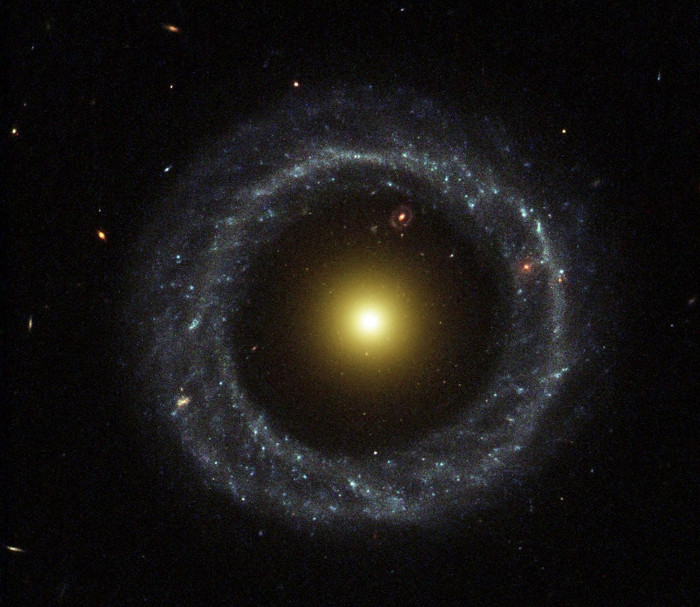Detecting exotic galaxies, about 359 million light-years from Earth
Scientists have discovered a rare galaxy, about 359 million light-years from Earth, that has a unique circular structure that has never been seen before.
The galaxy is named PGC 1000714 , called the ring galaxy - consisting of young stars lying in a circle around the older galactic core.
On closer inspection, the scientists realized that this galactic core was not only surrounded by one, but two star rings . This is the first time astronomers have encountered this phenomenon.
The most common types of galaxies in the universe that we know are generally disk-shaped, with stars stretching into ellipses or into a spiral like our Milky Way.
But many other irregularly shaped galaxies still exist, including ring galaxies like the Hoag Galaxy, discovered by astronomer Arthur Hoag in 1950.

Hoag Galaxy.
Unlike disk galaxies - stars are often spread out and dispersed outward - stars in the ring galaxy are divided into two different groups: a ring of young stars radiating blue very brilliant outside, and an inner core with older and less bright stars.
Ring galaxies are very rare in the universe, so the discovery of PGC 1000714 has two rings that make scientists very excited.
"This is like catching a snow leopard or other rare rare animals. The galaxy is like the Hoag Galaxy, with a star circle around a single core that is already rare, and now we discover it again. a galaxy like that that comes in two rings, it's unique, " said astronomer Patrick Treuthardt, North Carolina Natural Science Museum.
Treuthardt and his colleagues analyzed PGC 1000714 by Las Campanas Observatory in Chile, showing that the outer ring is full of blue stars just 0.13 billion years old, the inner core is the older red stars. , about 5.5 billion years old.
During the analysis, they found evidence of a second star ring inside the first ring. After careful consideration, the Treuthardt group called this ring "the older diffusion ring inside with red stars" , where the stars are older than the younger stars on the outer ring.
In the immediate future, there seems to be no link between these two rings. How can this happen? No one knows for sure, but it marks a new kind of celestial body that has never been found before.
"It is estimated that Hoag-type galaxies account for about 0.1% of the total observed galaxies, and in fact may be less than that," Treuthardt said.

PGC 1000714 galaxy image through two different wavelengths, showing its two inner and outer rings.(Photo: Ryan Beauchemin).
The researchers speculate that the PGC 1000714 that we are observing could be linked together by a force of mutual impact at different timelines. But since we haven't discovered a galaxy like that before, it's hard to be sure.
"The different colors of the inner and outer rings show that this galaxy has undergone two different formation stages. But from the original images recorded, it's hard to know the exact time. Two rings were formed, "said Burcin Mutlu-Pakdil, a member of the research team, University of Minnesota Duluth.
The team also speculated that the outer ring may have been created by a dust-rich galaxy that once existed. To determine the age of the inner ring, scientists say they need more data.
"We need to probe the inner part of the galaxy more. Perhaps something has come and interacted with the galaxy to form a ring, so it is good that we will examine the dust gas surrounding the galaxy. " Treuthardt said.
While there are still many unknowns about PGC 1000714 in particular and circular galaxies in general, researchers believe that such star systems will help science better understand the universe.
"Exceptional galaxies like PGC 1000714 challenge our theories, are an important aspect in science in understanding the universe and how the universe is made," Treuthardt adds.
- Unique picture of 2 galaxies colliding
- Andromeda galaxy will destroy the Earth
- How far can we stand from the Earth, can we see living dinosaurs?
- Discovered the galaxies about 10,000 million light-years from Earth
- New Hubble telescope image of the hybrid galaxy UGC 12591
- The bridge of gas over 2.6 million light years
- Detecting the galaxy seems to not exist
- Detecting the minimum mass of the galaxy
- NASA takes a picture of two colliding galaxies
- Two collision galaxies are 424 million light-years from Earth
- The battle between galaxies in the universe
- The largest structure in the universe contains just 1,600 galaxies
 Van Allen's belt and evidence that the Apollo 11 mission to the Moon was myth
Van Allen's belt and evidence that the Apollo 11 mission to the Moon was myth The levels of civilization in the universe (Kardashev scale)
The levels of civilization in the universe (Kardashev scale) Today Mars, the sun and the Earth are aligned
Today Mars, the sun and the Earth are aligned The Amazon owner announced a secret plan to build a space base for thousands of people
The Amazon owner announced a secret plan to build a space base for thousands of people